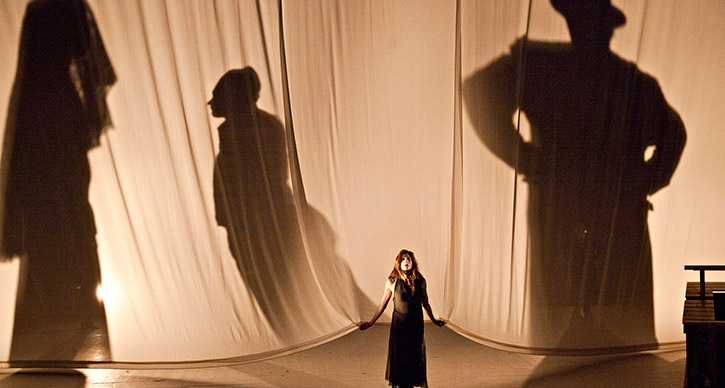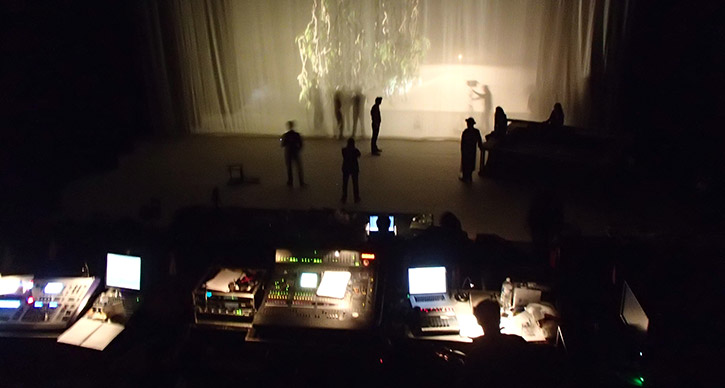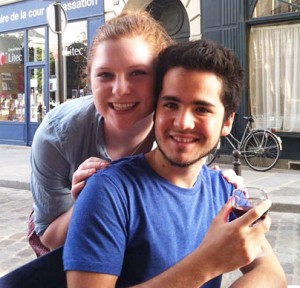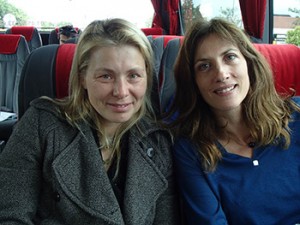Resident Update: Painter Carolyn Reed Barritt on Six Characters

Drawing by Carolyn Reed Barritt, inspired by Théâtre de la Ville.
Painter Carolyn Reed Barritt is a UMS Artist in Residence this season. We’ve asked five artists from across disciplines to take “residence” at our performances and to share the work these performances inspire.
Carolyn attended Théâtre de la Ville’s Six Characters in Search of an Author on October 24-25, 2014. She shares her thoughts and drawings:
“Overwhelmed. That’s how I felt when the play started. I don’t speak French, so trying to watch the actors and look at the set while reading the supertitled translations filled me with dread. How was any of this going to inspire anything for me except frustration? …..Over the past few days while thinking about the play, and about conscienceness and reality, I have been working on one drawing, then another and then going back and forth between several.”
Read the full post on Carolyn’s blog
Interested in learning more? Read our interview with Carolyn.
Student Spotlight: Could You Repeat That? and Other Stories from Paris
Editor’s Note: Clare Brennan is a junior at the University of Michigan. This past summer she interned for ANRAT, a theater research company in Paris co-founded by Emmanuel Demarcy-Mota, director at Théàtre de la Ville. Their production of Pirandello’s Six Characters in Search of an Author comes to UMS October 24th and 25th.
The summer of 2014 consisted mainly of getting lost. As a first-timer to the grand city of Paris, or to any sort of international travel for that matter, I had incessantly practiced the correct way to ask for directions to the bus stop during my entire eight hour flight. Before I could get a “Bonjour” in edgewise, a bored flight attendant directed me towards my destination in perfect English, and I was on my way.
I’d gladly forget my first trek from the airport to the dorms, dragging my two oversized suitcases across town, but after the jetlag wore off, I started to get the hang of things. I became a lover of maps, discovering the metro system as quickly as possible. That knowledge invariably went out the window as soon as summer construction began. Eventually, I started ending up in the same places, and what was once a completely strange conglomerate of streets started feeling a little more like home.
Once settled in, I dove into the incredible wealth of theater surrounding me. With over 150 professional theaters within its city limits, Paris never let quantity deteriorate quality. One of my first shows was Ionesco’s Rhinocéros at Théàtre de la Ville. I had missed the production when it came to UMS last season, and was so excited when fellow UMS intern Flores Komatsu offered up a ticket to join him. We met at the theater and crossed one of the many bridges that connect the vastly different banks of the river to find a small café for dinner. A group of men of various ages played pétanque, the French equivalent of bocci ball, on a dirt patch next to us, a common pastime on summer evenings. Obviously American, we prattled away, catching up on upcoming projects, book recommendations, and travel plans. Eventually, the couple from Colorado sitting next to us struck up a conversation, and after twenty minutes we had learned the story of their ex-pat daughter and swapped recipes for favorite dishes we’ve discovered. Caught up in conversation, we barely realized we were running dangerously close to curtain time. We sprinted back to the theater and found our seats with just enough time to absorb the atmosphere.
*
I love theaters. Between their velvet curtains and cushioned seats, both actor and audience member gain some security to suspend their disbelief for a while and hear a story. I appreciate that sense of trust that seems built into the walls, and I always try and find it again before every show I see.
At Théàtre de la Ville, the most striking quality I found was its size, housing around 1,500. Our Monday evening show was sold out, and as I looked around, I noticed that most of those in attendance were around my age. In my exploration of the arts at home, I’ve often found truly invested younger patrons more difficult to find. There, young people come to shows, stay for talkbacks, and attend season premieres; Théàtre de la Ville’s season announcement, for instance, packed the house just as tightly as their best-known runs.

Photo: Le Palais de Pape, where “I Am” played during the Avignon Theater Festival in July. Photo by Clare Brennan
The house lights dimmed, and I experienced again what would quickly become one of my favorite culture moments abroad. Before an actor ever sets foot on stage, a score of audience members will audibly shush one another. It will be hard to forget my first experience of this sort, as the majority of hisses were directed at me. Foreign air and a lack of sleep had left me sick for a couple weeks, and, apparently, I thought that the start of the Moroccan acrobatic performance Azimut at Théàtre du Rond Point would be a lovely time for a coughing fit; the surrounding patrons did not. I quickly picked up this less-than-subtle social cue, and by the end of my two months, I was joining in as passive-aggressively as possible. Strong reactions like this were never out of place. At the Avignon Theater Festival, a production of Lemi Ponifasio’s I Am, a World War II homage in dance, produced critical laughter, side comments, even a small exodus after a particularly difficult movement. However, with this piece included, I also never saw a performance without at least five minutes of applause at the close.
*
Seeing theater in a foreign language took a bit of adjustment. Rhinocéros opens with a beautiful monologue. I couldn’t tell you what the first few lines mean now, as I was still looking for surtitles within the first few moments before I remembered where I was. I did have opportunities to try reading French surtitles during a Dutch production of Ayn Rand’s The Fountainhead and a Japanese kabuki style of the Mahabharata. Reading and translating French while listening to another language with which I had no experience left my American brain a little withered, but it did help me to abandon any pretenses I had when I arrived and dedicate a couple of hours to a completely new experience. Or four and a half hours, in the case of the Dutch Fountainhead. (I have to admit, I dozed off for about twenty minutes of that. I read the book in high school, so that counts, right?)
That night, Flores and I left the theater and lingered on the rainy sidewalk with a crowd of theatergoers doing the same. We all shared our thoughts, compared interpretations, raved over actors, and tried to weave our way through the denser moments. We said our goodbyes for the night, and as I turned to leave, I realized that I was pretty disoriented. I was lost in Paris again, but what else was new. Theater abroad left me dizzy and buzzing, not quite sure of where I stood but happy that I was there. I was used to the feeling by now, and there could be worse places to get turned around. Paris is a city for wandering, anyway.
Artist Interview: Traveling with Théâtre de la Ville
Editor’s note: This summer, UMS launched a new 21st Century Artist Internships program. Four students interned for a minimum of five weeks with a dance, theater, or music ensemble part of our 2014-2015 season. Héctor Flores Komatsu is one of these students. He spent five weeks with Théâtre de la Ville in Paris, France.

Théâtre de la Ville performs Six Characters in Search of An Author at the Power Center in Ann Arbor on October 24-25, 2014. Photo by JL Fernandez.
Scene
13:30, May 23, 2014, Paris, France. En route to final dress rehearsals of Six Characters in Search of an Author at Le Forum Blanc Mesnil, a banlieu (suburb) located at the northern outskirts of the city proper. Cast and production members sit throughout the van shuttle between Théâtre de la Ville and our current rehearsal space.
Les mecs (the dudes) hang out in the back, and one of their phones alternates between the American and French pop hits of the moment. Some nap, some read, some eat their lunch. They converse in the relaxed, soft, yet gutturally vibrant and “chic” French that had initially been both inviting and intimidating to my Mexican-American mélange of an accent.
Actress Sarah Karbasnikoff’s sweet, edgy, yet motherly voice, proper for her character, rises in joyous laughter, while actress Valerie Dashwood’s dark, yet subdued, cedar timbre seduces the air with chuckles, not unlike those heard from her character, the Step-Daughter. The laughter is inviting, I sit across them, speaking in “tu,” not “vous,” as they had requested.
We chat for the readers in Ann Arbor, of which Sarah has fond memories with Rhinos stampeding through the fallen autumn foliage. (Théâtre de la Ville last visited Ann Arbor to perform Ionesco’s Rhinocéros in 2012.)
Héctor Flores Komatsu: You are a very interesting mother-daughter stage pair! Could you talk a bit about your characters’ relationship in the show?
Sarah Karbasnikoff: Well, I play the Mother, who… Let’s just say she suddenly arrives at the theater with her first husband and all of her children.
HFK: Hmm…
Sarah: Ha! That’s what you need to know, I don’t think I should say more!
[Laughter]
Valerie Dashwood: As for me, I play the “Step-Daughter.” She is such because her mother…
Sarah: That’s me…
Valerie: Was initially married to the character of the Father, with whom she had…
Sarah: A boy.
Valerie: Yes, a boy… Just one boy.
Sarah: Voila!
Valerie: Afterwards, she “had” a second man, my true father, with whom she had three children of which I play the eldest, the Daughter.
HFK: What would you then say is the fundamental need, desire, of the mother, of the Step-Daughter, of the family as a whole? What is it? Is it love? Is it to unite the entire family? Is there a common desire as a family?
Sarah: Well, that will certainly differ for each character.
Valerie: For the Step-Daughter there’s no need or desire to be part the family. One of the first things she says is that she “will take off – fly away!” because she doesn’t want to be part of it.
Deep inside, she detests her Step-father, and she also hates his first, legitimate, son. She speaks a lot about legitimacy, because perhaps she doesn’t feel entirely legitimate. She doesn’t have legitimacy even within society, given that she’s had to prostitute herself to support her mother and siblings. That’s her point of view.
Her desire is, more than anything, is to self-destruct, through which she can emancipate herself from her family, become and adult.
HFK: She fights for her freedom!
Valerie: She fights for her freedom!
HFK: For the mother it seems to be quite the opposite.
Sarah: Each day I discover her a little more. At this moment I have the impression that, yes, she seeks to see her son again, that is certain, because she wasn’t there for him, and so there’s some degree of guilt. Her two youngest children die, and eldest daughter wishes to escape from her. So yes, her greatest desire is to bring everyone together but, alas, that’s impossible. Her life is her children, all of whom escape from her, leave her.

During rehearsal with Théâtre de la Ville. Photo by Héctor Flores Komatsu.
HFK: How has the process been for you, as a new actress in this restaging, stepping into a role originated by someone else?
Sarah: Well, first one must do what’s already been done and understand what already exists. I’ve been stepping into the shoes of the original actress.
And now, with each run, I begin to understand the reason behind her movements, the psychological motivations. At first they were mere just movements, crossing from one place to another, and I simply memorized them; it was very concrete, very technical work. And then, from that point, I began to create the character.
HFK: For you Valerie, having played this role in the original production twelve years ago, what has it been like this time? What has been unearthed once more? What has been newly discovered?
Valerie: What’s been really interesting for me, since it’s been twelve years since I played this role in the original production, is that upon returning to this play, I could not perfectly recall many specifics, but I still had a global feeling of the character, the violence, the pain, and of the will – that’s what it is! The will of the character, is what I remembered well.
However, I could barely remember the text – except for the song! Bizarrely, that had completely stayed with me; I remembered the song… but not my lines!
But then when we read out the play all together at Théâtre de la Ville, with Hugues [Quester, who plays the Father] and Alain [Libolt, who plays the Director], hearing their voices and feeling their energies through the text, the memory came back to me. By reading with them, I was surprised to feel the same emotions from years ago resurface, as if something which long laid dormant suddenly awoke, opening itself. Voila!
After that, relearning the text was very easy.
HFK: What is different today, than how it was twelve years ago?
Valerie: The biggest difference is that twelve years ago I didn’t have children, and now I’ve had two. So my maternal instinct, the one my character has for her little sister, feels very different. Motherhood has hit me hard, and it affects how I act, even in the way I look at the little girl. Sans resorting to any psychological tricks, I instinctively see my daughter in the little girl. I have a child now… And that fact greatly affects how I act, knowing that this little girl, in the play, will die.
I don’t think I could ever do this in the same way as I did twelve years go.
Also, having worked so much in just the past ten years, I feel much more physically available in my own body, much more reserved. At the time, the nudity had originally been somewhat difficult for me, but much less so nowadays. That scene, which I came to fear, I now approach with serenity, even when it’s hard to play.
HFK: And now for my last question for you. I’ve noticed that there’s a lot of love and care behind the scenes among the cast. And for you two, who play Mother and Daughter on stage but are much closer in friendship and in age off-stage, how does that affect your stage relationship?
Valerie: All I can say is… Just like in our previous play, I played the mother to Sandra [another Théâtre de la Ville actress who also plays one of the “actresses” in Six Characters]. I never feel the need to ask myself whether this is or isn’t “coherent,” even if we are only twelve years apart. In theatre, we have what we call, at least in French, a “convention” to suspend disbelief. So right now, Sarah may be playing my mother, and we understand each other really well, which is good because playing this relationship requires great emotional investment. We can support that off-stage. Our closeness strengthens the bond vital to plunging into the work together.
Sarah: For me it’s very similar. During the show I don’t think at all about the age difference. To feel Valerie as she plays her character, I do nothing more than to say “she’s my daughter.” That’s it, I don’t see the age at all. There’s also an understanding of our respective pains, because we know each other personally. That really gets me, it truly does. She does, her pain. She might not truly be her character, but we form an affinity, a bond.
We streamline into casual conversation, and soon enough arrive at the theater. An hour into the rehearsal, as everybody gets into costume and warms into their roles Valerie receives a phone call. Her youngest child isn’t feeling well. She ponders the symptoms, trying to figure the right remedy. There’s the natural concern of the working actress-mother in the midst of rehearsals. She seeks her stage-mother Sarah, a veteran mother in various senses, for reassurance. That’ll do it,” Sarah says. For a moment, the parallel lines of reality and fiction intersect, not unlike in the play, as the two women connect through maternity.
Interested in more? Look for Flores’s behind-the-scenes photo-essay covering his time with the company.




